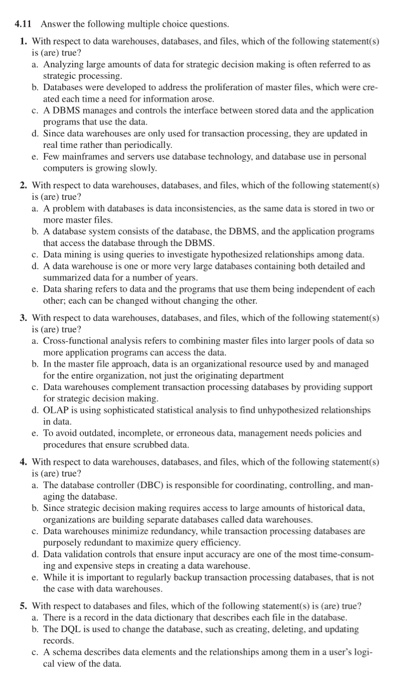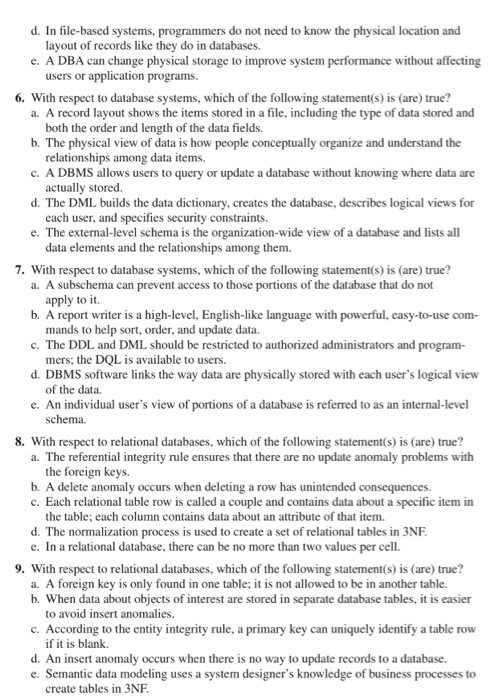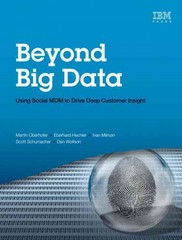4.11 Answer the following multiple choice questions. 1. With respect to data warehouses, databases, and files, which of the following statement s) is (are) true? a. Analyzing large amounts of data for strategic decision making is often referred to as strategic processing. b. Databases were developed to address the proliferation of master files, which were cre- ated each time a need for information arose. e. A DBMS manages and controls the interface between stored data and the application programs that use the data. d. Since data warehouses are only used for transaction processing, they are updated in real time rather than periodically e. Few mainframes and servers use database technology, and database use in personal computers is growing slowly. 2. With respect to data warehouses, databases, and files, which of the following statement(s) Is (are) true? a. A problem with databases is data inconsistencies, as the same data is stored in two or more master files. b. A database system consists of the database, the DBMS, and the application programs that access the database through the DBMS c. Data mining is using queries to investigate hypothesized relationships among data. d. A data warehouse is one or more very large databases containing both detailed and summarized data for a number of years e. Data sharing refers to data and the programs that use them being independent of each other, each can be changed without changing the other 3. With respect to data warehouses, databases, and files, which of the following statement s) is (are) true? a. Cross-functional analysis refers to combining master files into larger pools of data so more application programs can access the data. b. In the master file approach, data is an organizational resource used by and managed for the entire organization, not just the originating department c. Data warehouses complement transaction processing databases by providing support for strategic decision making. d. OLAP is using sophisticated statistical analysis to find unhypothesized relationships in data. e. To avoid outdated, incomplete, or erroneous data, management needs policies and procedures that ensure scrubbed data. 4. With respect to data warehouses, databases, and files, which of the following statement s) is (are) true? a. The database controller (DBC) is responsible for coordinating, controlling, and man- aging the database b. Since strategic decision making requires access to large amounts of historical data, organizations are building separate databases called data warehouses. c. Data warehouses minimize redundancy, while transaction processing databases are purposely redundant to maximize query efficiency d. Data validation controls that ensure input accuracy are one of the most time-consum- ing and expensive steps in creating a data warehouse. e. While it is important to regularly backup transaction processing databases, that is not the case with data warchouses. 5. With respect to databases and files, which of the following statement(s) is (are) true? a. There is a record in the data dictionary that describes each file in the database b. The DOL is used to change the database, such as creating, deleting, and updating records. c. A schema describes data elements and the relationships among them in a user's logi- cal view of the data. 4.11 Answer the following multiple choice questions. 1. With respect to data warehouses, databases, and files, which of the following statement s) is (are) true? a. Analyzing large amounts of data for strategic decision making is often referred to as strategic processing. b. Databases were developed to address the proliferation of master files, which were cre- ated each time a need for information arose. e. A DBMS manages and controls the interface between stored data and the application programs that use the data. d. Since data warehouses are only used for transaction processing, they are updated in real time rather than periodically e. Few mainframes and servers use database technology, and database use in personal computers is growing slowly. 2. With respect to data warehouses, databases, and files, which of the following statement(s) Is (are) true? a. A problem with databases is data inconsistencies, as the same data is stored in two or more master files. b. A database system consists of the database, the DBMS, and the application programs that access the database through the DBMS c. Data mining is using queries to investigate hypothesized relationships among data. d. A data warehouse is one or more very large databases containing both detailed and summarized data for a number of years e. Data sharing refers to data and the programs that use them being independent of each other, each can be changed without changing the other 3. With respect to data warehouses, databases, and files, which of the following statement s) is (are) true? a. Cross-functional analysis refers to combining master files into larger pools of data so more application programs can access the data. b. In the master file approach, data is an organizational resource used by and managed for the entire organization, not just the originating department c. Data warehouses complement transaction processing databases by providing support for strategic decision making. d. OLAP is using sophisticated statistical analysis to find unhypothesized relationships in data. e. To avoid outdated, incomplete, or erroneous data, management needs policies and procedures that ensure scrubbed data. 4. With respect to data warehouses, databases, and files, which of the following statement s) is (are) true? a. The database controller (DBC) is responsible for coordinating, controlling, and man- aging the database b. Since strategic decision making requires access to large amounts of historical data, organizations are building separate databases called data warehouses. c. Data warehouses minimize redundancy, while transaction processing databases are purposely redundant to maximize query efficiency d. Data validation controls that ensure input accuracy are one of the most time-consum- ing and expensive steps in creating a data warehouse. e. While it is important to regularly backup transaction processing databases, that is not the case with data warchouses. 5. With respect to databases and files, which of the following statement(s) is (are) true? a. There is a record in the data dictionary that describes each file in the database b. The DOL is used to change the database, such as creating, deleting, and updating records. c. A schema describes data elements and the relationships among them in a user's logi- cal view of the data








